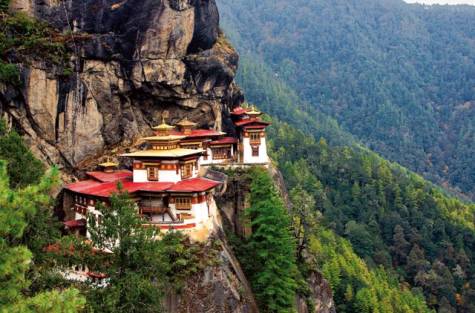While some countries are famous for their exports and others for their mammoth monuments, the Himalayan Kingdom-turned-democracy of Bhutan is best known for its smiles. The 100-year-old royal family has, for many decades and now famously, measured the success of the tiny country – which is half the size of Scotland and nestled between the two giants of India and China – by the Gross National Happiness Index rather than the Gross National Product. Meaning how content the people are is more important to them than how much money they can make – begging the question: ‘When can we move there?’
It’s hard to get there but worth the trip
Dubbed The Land Of The Thunder Dragon by its people, and ‘The World’s Last Shangri-La’ by its aficionados, Bhutan, which has been inhabited by humans for four millennia, is a place like no other. Plastic bags and cigarettes are illegal, Bhutanese people are legally required to wear their national dress, people snack on raw chillies like we do on crisps, TV was banned until 1999 and life is still very similar to how it was hundreds of years ago.
As it’s such a unique place, any Tom, Dick or Harry can’t just book a package bus tour and leave their litter strewn around the beautiful mountainous and evergreen countryside. Oh no, in order to preserve the unique scenery and spiritual calm of the country, visitors to the kingdom have to wire transfer around Dh700 per day that they plan to visit before their visa is even granted.
But once in Bhutan, this fee covers all meals, internal transport and trekking arrangements, an obligatory guide (no exceptions!) and basic accommodation (there are luxury resorts that require an extra fee). And while this may all seem like a bit of a hassle, we say go now.
Why? Because three regional airports are currently being built and new parts of the country are opening up to tourism, so Bhutan may well be a shadow of its former quirky self a mere decade from now.
The tiger’s nest
The most famous image of Bhutan is of the Tiger’s Nest Monastery, or Taktshang Goemba, a 320-year-old place of pilgrimage that clings precariously to an almost-vertical, 3,200 metre-high cliff. Just 10 kilometres away from the city of Paro (which is where you fly into), legend has it that the man credited with bringing Buddhism to Bhutan, Padmasambhava, flew to the sacred cliff where the monastery is perched, on the back of a tigress (hence the name) in the Eighth century. He then meditated there for three months, three weeks, three days and three hours.
And while you won’t need to find a mythical flying creature to visit the cloud-shrouded building, it does require a three hour – and very steep – hike. But when that ascent is accompanied by sights of blue pine forests and the sound of gurgling mountain streams, it’s not such a chore.
Make sure to stop for tea and biscuits on the way up and lunch on the way down at the Tiger’s Nest Cafeteria, which is about an hour into the journey and serves a buffet of purely vegetarian food (you’ll deserve the potatoes with cheese after your 1,600-step climb).
The most relaxed city in the world
The world’s only capital city without traffic lights – white-gloved policemen direct cars – Thimphu (which has been the capital since 1961) is a must on any Bhutan itinerary. The city of around 80,000 people is approached via one winding, single-lane access road, and its beautifully green centre is home to parks, a dragon-adorned open air theatre with a craft market and a swag of shops, small hotels and bars and restaurants.
While there you can wander up the hill to Buddha Point, where a large golden statue looms over the city (head up on a clear day for beautiful views of the Paro Valley and the city nestled within it). Or you can take a three-hour drive to the beautiful rice fields around Punakha, which was the capital until it was replaced by Thimphu. Also make sure to stop by the National Textile Museum in Thimphu to see how the traditional cloths the Bhutanese wear are made, and even pick some up for yourself.
After all this activity, you should give yourself time to just soak up the city and observe the happily slow pace its citizens – and in fact most Bhutanese – live at. We could learn a thing or two from them…
Stay here
Budget: Dewachen Hotel
Set against the beautiful Phobjikha Valley, this peaceful hotel offers 16 spacious, traditional-style rooms, gorgeous views of the surrounding pine forests and valley as well as a great chance to spot the rare Blacknecked crane. There are horse-riding facilities, a traditional hot-stone bath and a traditional restaurant, too.
Mid-range: Tiger’s Nest Hotel
This is possibly the only hotel in Bhutan that has a view of the famous Tiger’s Nest Monastery. This and the elegantly carved wooden walls, startlingly fresh mountain air and all-vegetarian menu, will have you as relaxed as the locals in no time.
Luxury: Taj Tashi Thimphu
Nestled against a valley in the capital city of Thimphu, this marigold-hued hotel has 66 high-ceilinged, luxurious rooms with views over the Himalayas. Wake up early to hear the monk who chants prayers in the courtyard, or stay up late to watch traditional dancers and sample Bhutan’s national dish – ema datshi, which is melted cheese with grated chilli (yum!) Rooms .
